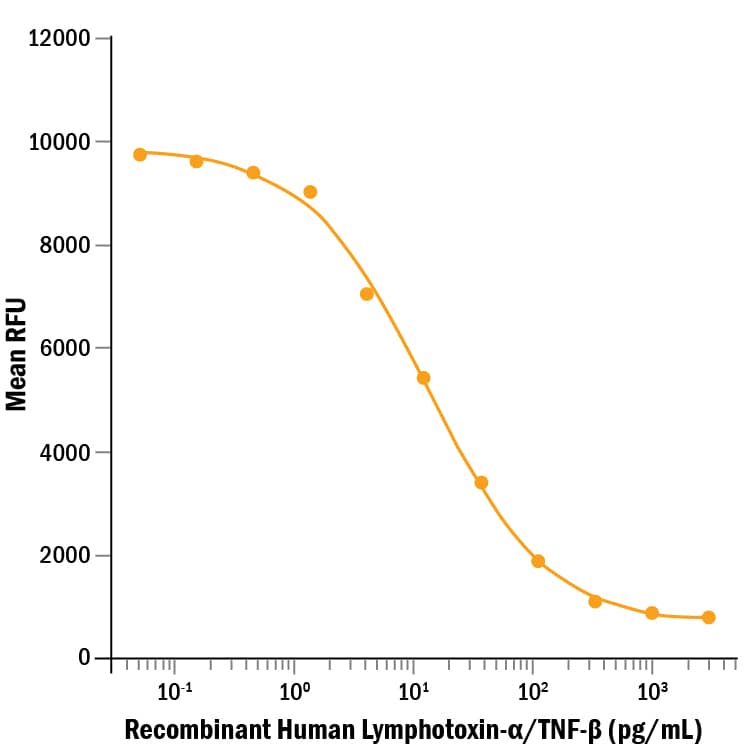Recombinant Human Lymphotoxin-alpha/TNF-beta Protein
R&D Systems, part of Bio-Techne | Catalog # 211-TBB

Key Product Details
Product Specifications
Source
Leu35-Leu205, with an N-terminal Met
Purity
Endotoxin Level
N-terminal Sequence Analysis
Predicted Molecular Mass
SDS-PAGE
Activity
The ED50 for this effect is 4-20 pg/mL.
Reviewed Applications
Read 1 review rated 5 using 211-TBB in the following applications:
Scientific Data Images for Recombinant Human Lymphotoxin-alpha/TNF-beta Protein
Recombinant Human Lymphotoxin-alpha/TNF-beta Protein Bioactivity
Recombinant Human Lymphotoxin-alpha /TNF-beta (Catalog # 211-TBB) induces cytotoxicity in the L-929 mouse fibroblast cell line in the presence of the metabolic inhibitor actinomycin D. The ED50 for this effect is 4-20 pg/mL.Recombinant Human Lymphotoxin-alpha/TNF-beta Protein SDS-PAGE
1 µg/lane of Recombinant Human Lymphotoxin-alpha /TNF-beta was resolved with SDS-PAGE under reducing (R) conditions and visualized by silver staining, showing a band at 19 kDa.Formulation, Preparation and Storage
Carrier Free
What does CF mean?CF stands for Carrier Free (CF). We typically add Bovine Serum Albumin (BSA) as a carrier protein to our recombinant proteins. Adding a carrier protein enhances protein stability, increases shelf-life, and allows the recombinant protein to be stored at a more dilute concentration. The carrier free version does not contain BSA.
What formulation is right for me?In general, we advise purchasing the recombinant protein with BSA for use in cell or tissue culture, or as an ELISA standard. In contrast, the carrier free protein is recommended for applications, in which the presence of BSA could interfere.
Carrier: 211-TBB
| Formulation | Lyophilized from a 0.2 μm filtered solution in PBS with BSA as a carrier protein. |
| Reconstitution | Reconstitute at 100 μg/mL in PBS containing at least 0.1% human or bovine serum albumin. |
| Shipping | The product is shipped at ambient temperature. Upon receipt, store it immediately at the temperature recommended below. |
| Stability & Storage | Use a manual defrost freezer and avoid repeated freeze-thaw cycles.
|
Carrier Free: 211-TBB/CF
| Formulation | Lyophilized from a 0.2 μm filtered solution in PBS. |
| Reconstitution | Reconstitute at 100 μg/mL in PBS. |
| Shipping | The product is shipped at ambient temperature. Upon receipt, store it immediately at the temperature recommended below. |
| Stability & Storage | Use a manual defrost freezer and avoid repeated freeze-thaw cycles.
|
Background: Lymphotoxin-alpha/TNF-beta
Lymphotoxin-alpha (LT-alpha), also known as Tumor Necrosis Factor-beta (TNF-beta), is a member of the TNF Superfamily. Human LT-alpha /TNF-beta is a 22 kDa protein that shares 73% amino acid sequence identity with mouse and rat LT-alpha /TNF-beta (1-3). Secreted LT-alpha forms homotrimers that bind and activate TNF RI/TNFRSF1A, TNF RII/TNFRSF1B, and HVEM/TNFRSF14 (4). LT-alpha /TNF-beta also forms heterotrimers with plasma membrane-localized LT-beta to bind and activate the LT-beta R/TNFRSF3 (4). In addition to its cytotoxic action on tumor cells, LT-alpha /TNF-beta mediates lymph node development, inflammation, and immune function (5-8). LT-alpha /TNF-beta is expressed in activated T- and B lymphocytes and contributes to autoimmune disease (9, 10).
References
- Nedwin, G.E. et al. (1985) J. Cell. Biochem. 29:171.
- Gray, P.W. et al. (1984) Nature 312:721.
- Kobayashi, Y. et al. (1986) J. Biochem. 100:727.
- Warzocha, K. et al. (1995) Eur. Cytokine Netw. 6:83.
- McCarthy, D.D. et al.(2006) Immunol. Res. 35:41.
- Drutskaya, M.S. et al. (2010) IUBMB Life 62:283.
- De Togni, P. et al. (1994) Science 264:703.
- Seleznik, G.M. et al. (2014) Cytokine Growth Factor Rev. 25:125.
- Mapara, M.Y. et al. (1994) Int. J. Cancer 58:248.
- Chiang, E.Y. et al. (2009) Nat. Med. 15:766.
Long Name
Alternate Names
Gene Symbol
UniProt
Additional Lymphotoxin-alpha/TNF-beta Products
Product Documents for Recombinant Human Lymphotoxin-alpha/TNF-beta Protein
Product Specific Notices for Recombinant Human Lymphotoxin-alpha/TNF-beta Protein
For research use only

